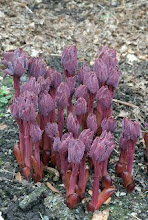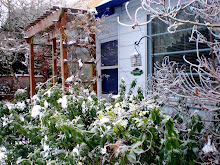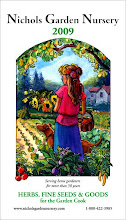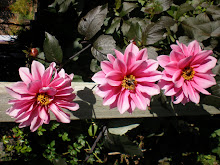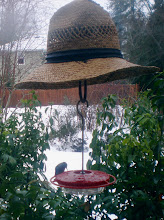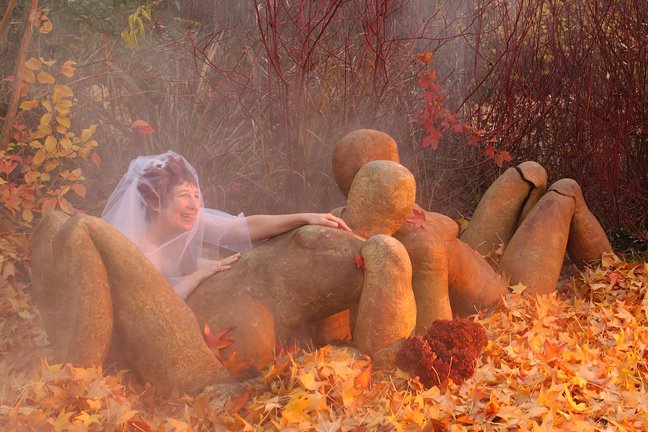For me, the garden is the best home I’ve ever made for myself. It’s where I relish the refreshing scent of rosemary and the smoky tints of ‘Hot Cocoa’ roses, that remind me of taffeta skirts. I love to listen to the bush tits whistle, to the chickadees and song sparrows belting out their arias.
Maybe because I grew up in a home where cleaning and cooking were accompanied by heavy sighs, I never took pleasure in housework. But out in the garden, most every job, except for mowing, is fun for me. My first garden teacher, Frank Curtis, radiated so much love for gardening that I caught the bug. He did everything with tender loving care, from settling his baby tomato plants into the soil, to nipping out the suckers, from building a compost pile to turning the soil. He taught me everything he knew—how and when to sow seeds, how to wield a mattock, which plants were weeds—with so much joy! His enthusiasm was contagious.
From the beginning, gardening connected me with a big world of emerging life—woody stems swelling with buds, tiny hellebore seedlings sprouting beneath the mother plants, iridescent black beetles climbing out from a pile of damp leaves. Sometimes I even stop to marvel at the persistence of weeds, at the temerity of slugs and aphids.
If I help out, the wetland I live on becomes a better garden. The native clay soil, for example, is a perfect medium for growing plants—once I amend it with pumice or crushed rock for better drainage, and with compost for more fertility and tilth. The garden needs me to bring it to fruition—we become partners in creation. What a miracle that is!
It’s still work, but in the spirit of joy and play. I take a brain vacation while I’m digging, raking or weeding. A writer’s mind, always busy with words and phrases and punctuation, needs a break from all that mental activity. And I’m guessing that most all of our minds are overloaded with blather and can use a good airing out in the garden.
Even in winter, there’s plenty to do. This week I cut back all the old leaves on the hellebores. There, peeking out from underneath, are the new buds, almost ready to open. One dark purple hellebore is already showing its beautiful face. And here and there, small grey slugs lounge beneath the leaves, growing fatter each day. It’s an easy choice between the flowers and the slugs—slugs gotta go!
Soon it will be time to prune the grape arbor and the roses, but not quite yet. Jumping the gun now could mean exposing the newly pruned plants to the next cold front. I can wait. Meanwhile, I can safely cut back all the deadened stems of totally hardy perennials like turtleflowers, asters, and gooseneck loosestrife. The compost piles grow tall and hefty with leaves, kitchen peelings and old potting soil, waiting for the next rain to pack them down.
Monday, January 19, 2009
Saturday, January 10, 2009
Here Come the Catalogs
I love the avalanche of catalogs that floods my mailbox in January. Thanks goodness it’s an oversize mailbox or it would have collapsed under the tonnage. The covers alone thrill me—images of pink lilies and and illustrations of golden beets vie for my attention.
Nichols Garden Nursery (www.NicholsGardenNursery.com), celebrating its 60th year, has a beautiful cover that takes me back to slower times. Framed by a pear tree, a young woman gathers sunflowers, accompanied by her adorable dog.
I e-mailed artist Marcie Hawthorne (www.marciehawthorne.com) to let her know how much I love her work, and to request permission to post the cover on my blog. In her reply, she told me more about the illustration.
“This year the artwork depicts my daughter, Sierra, when she was younger, and our beloved (and now departed) female Ridgeback, Teneya, who also was a constant companion in the
garden,” she wrote.
Inside the catalog, vegetable, flower and herb seeds for sale are accompanied by mouthwatering descriptions. Supplies for making cheese, home brewing and wine making will also give you new ideas for 2009.
Rose Marie Nichols McGee and her husband Keane McGee carry on the business that her parents began in 1948. And together with Maggie Stuckey, Rose Marie wrote “The Bountiful Container,” now in its fourth printing. It shows you how to create container gardens of veggies, herbs, fruits and edible flowers.
“People don’t have enough room to do these big gardens. They want a small garden that can yield twelve months a year,” she says. For example, Survivor Parsley can be harvested longer than any other variety.
“It has more sugars in the leaves, and sugars help the plant survive,” Nichols says.
I have a soft spot in my heart for Bluestone Perennials—it was the first mail order catalog I used back in the days when I couldn’t find enough selection in local nurseries (hard to believe now). Their offerings remain tempting and their 15% early discount helps offset the shipping charge. I’m smitten by Agastache ‘Raspberry Summer,’ Sedum ‘Picolette,’ and Kolkwitzia ‘Dream Catcher,’ to name just a few enticements. You can request a free color catalog at their website (www.bluestoneperennials.com) and also check out their tempting half price on-line-only specials.
Leafing through the White Flower Farm catalog is like walking through a spring and summer garden. The lush color photos practically jump off the page, especially the dazzling dahlia display. Most of all I love the container collections, which make me want to plant more annuals next summer. The way to offset the shipping is to order a $50 (or more) gift certificate and get a 10% discount on your order.
Some of my most unusual plants have come from forestfarm (www.forestfarm.com), a major source of woody and herbaceous ornamentals, located in Williams, Oregon. At the website you can see color photos of the plants, and order a free print copy of the catalog which will serve as a terrific reference book. I usually order the more economical tubes (which have always been thick with well-formed roots) and then grow them on in larger pots. You’ll be amazed at their offerings of viburnum, hydrangea, eucalyptus, pine, crape myrtle, willow....
Nichols Garden Nursery (www.NicholsGardenNursery.com), celebrating its 60th year, has a beautiful cover that takes me back to slower times. Framed by a pear tree, a young woman gathers sunflowers, accompanied by her adorable dog.
I e-mailed artist Marcie Hawthorne (www.marciehawthorne.com) to let her know how much I love her work, and to request permission to post the cover on my blog. In her reply, she told me more about the illustration.
“This year the artwork depicts my daughter, Sierra, when she was younger, and our beloved (and now departed) female Ridgeback, Teneya, who also was a constant companion in the
garden,” she wrote.
Inside the catalog, vegetable, flower and herb seeds for sale are accompanied by mouthwatering descriptions. Supplies for making cheese, home brewing and wine making will also give you new ideas for 2009.
Rose Marie Nichols McGee and her husband Keane McGee carry on the business that her parents began in 1948. And together with Maggie Stuckey, Rose Marie wrote “The Bountiful Container,” now in its fourth printing. It shows you how to create container gardens of veggies, herbs, fruits and edible flowers.
“People don’t have enough room to do these big gardens. They want a small garden that can yield twelve months a year,” she says. For example, Survivor Parsley can be harvested longer than any other variety.
“It has more sugars in the leaves, and sugars help the plant survive,” Nichols says.
I have a soft spot in my heart for Bluestone Perennials—it was the first mail order catalog I used back in the days when I couldn’t find enough selection in local nurseries (hard to believe now). Their offerings remain tempting and their 15% early discount helps offset the shipping charge. I’m smitten by Agastache ‘Raspberry Summer,’ Sedum ‘Picolette,’ and Kolkwitzia ‘Dream Catcher,’ to name just a few enticements. You can request a free color catalog at their website (www.bluestoneperennials.com) and also check out their tempting half price on-line-only specials.
Leafing through the White Flower Farm catalog is like walking through a spring and summer garden. The lush color photos practically jump off the page, especially the dazzling dahlia display. Most of all I love the container collections, which make me want to plant more annuals next summer. The way to offset the shipping is to order a $50 (or more) gift certificate and get a 10% discount on your order.
Some of my most unusual plants have come from forestfarm (www.forestfarm.com), a major source of woody and herbaceous ornamentals, located in Williams, Oregon. At the website you can see color photos of the plants, and order a free print copy of the catalog which will serve as a terrific reference book. I usually order the more economical tubes (which have always been thick with well-formed roots) and then grow them on in larger pots. You’ll be amazed at their offerings of viburnum, hydrangea, eucalyptus, pine, crape myrtle, willow....
Tuesday, January 6, 2009
Back in the Garden, At Last
Is It Winter or Spring?
During the snow storm, I’d taken apart my two piece terra cotta birdbaths and laid the tops—the basins—on the ground. In past years the weight of snow and ice would tip over the birdbaths, but not any more! In February I’ll reassemble them—for now they’ll stay put in case we have another cold front.
So this mild January morning, the birds were creative and found their own natural birdbath—the little bog had filled to the brim with rainwater. Splashing away freely, several robins sang heartily enough to wake me from my writing trance. I watched them through my office window, grabbing binoculars for a closer look. Plump, russet-breasted birds reveled in the fresh water, fluttering their wings and spraying droplets all around them. Oh yes! Then, flying across the garden, they swooped low and high. Praising the sun, the moisture, the worms now easy to pull from damp and mossy lawn.
Reluctantly, I left for an aerobics class at the gym, but made sure to drive straight home afterwards, without getting sidetracked. The afternoon remained dry and temperate, a perfect time for a reunion with my beloved garden—I’d been missing my connection with the earth for some weeks now.
I celebrated, along with the birds. Was it winter or spring? On Sunday it was snowing and today it was mild as May. It’s hard not to get spring fever when the birds are singing and bright green moss springs up through the lawn from so much moisture. I got out my long-handled loppers and pruned a big yellow-twig dogwood, taking out the thick older trunks, and leaving the newer, brighter stems. I raked up the last of the spiny sweet gum seedpods from the lawn, and filled the yard debris can to the top. I’ll sleep soundly tonight!
During the snow storm, I’d taken apart my two piece terra cotta birdbaths and laid the tops—the basins—on the ground. In past years the weight of snow and ice would tip over the birdbaths, but not any more! In February I’ll reassemble them—for now they’ll stay put in case we have another cold front.
So this mild January morning, the birds were creative and found their own natural birdbath—the little bog had filled to the brim with rainwater. Splashing away freely, several robins sang heartily enough to wake me from my writing trance. I watched them through my office window, grabbing binoculars for a closer look. Plump, russet-breasted birds reveled in the fresh water, fluttering their wings and spraying droplets all around them. Oh yes! Then, flying across the garden, they swooped low and high. Praising the sun, the moisture, the worms now easy to pull from damp and mossy lawn.
Reluctantly, I left for an aerobics class at the gym, but made sure to drive straight home afterwards, without getting sidetracked. The afternoon remained dry and temperate, a perfect time for a reunion with my beloved garden—I’d been missing my connection with the earth for some weeks now.
I celebrated, along with the birds. Was it winter or spring? On Sunday it was snowing and today it was mild as May. It’s hard not to get spring fever when the birds are singing and bright green moss springs up through the lawn from so much moisture. I got out my long-handled loppers and pruned a big yellow-twig dogwood, taking out the thick older trunks, and leaving the newer, brighter stems. I raked up the last of the spiny sweet gum seedpods from the lawn, and filled the yard debris can to the top. I’ll sleep soundly tonight!
Subscribe to:
Comments (Atom)



































